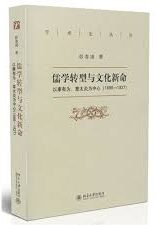
Peng Chunling 彭春凌
Beijing: Peking University Press, 2014
Reviewed by Xie Yifeng (PhD candidate, History, Fudan University)
Academia used to describe intellectuals in Late Qing and early Republican China, the major transformative period in modern Chinese history, through perspectives such as tradition versus anti-tradition and radicalism versus conservatism. Research in the last two decades revised the rigid image of anti-tradition associated with the New Culture Movement and paid more attention to aspects of continuity. The purpose of this book is to focus on anti-Confucianism in the new culture. The point is that so-called tradition never means solidification; and so-called new culture also does not mean everything should be changed. The relation between the two is not a binary opposition between tradition and modernity, but an “inheritance in fracture” (according to Luo Zhitian 羅志田)
The analysis of anti-Confucian action in the New Culture Movement is based on a perspective of Confucian transformation and refreshment. In the transformation period, Kang Youwei 康有為 and Zhang Taiyan 章太炎, as the two superstars in the intellectual world of the late Qing and early Republic, played the most significant roles. For this reason, the book focuses on these two figures, paying special attention to the horizontal and vertical interactions between them and other elites, such as Liang Qichao 梁啓超, the Zhou Brothers 周氏兄弟 and Chen Duxiu 陳獨秀.
After the Opium War and the Sino-Japanese War, facing the threat from the Western powers and Japan, young elites were fascinated by the doctrine of taking Confucius as an earthly leader and holy sage developed by Kang Youwei. However, after 1898, the process of Confucian transformation began to change, as actions to establish religious Confucianism were criticized. Kang’s former admirers, Zhang Taiyan and Liang Qichao, began to criticize Kang’s movement from their own perspectives and positions. Even Kang changed his own understanding of Confucianism to accord with the new situation. In Peng Chunling’s opinion, the key points of this process of transformation were: 1) Modern Nationalism radically challenged the universalism of Confucianism; 2) The integration between the positivism of Qing philology and the concept of modern western science continued to challenge religious Confucianism.
Although this book is a study in modern intellectual history, it also combines “internal history” and “external history.” In this case, so-called “internal history” is an in-depth interpretation and exploration of meanings of Chinese traditional history by Kang Youwei and Zhang Taiyan based on classics of the Pre-Qin and Han Dynasties; and so-called “external history” includes the influence of Japanese academia in the Meiji period and experiences in Taiwan for the intellectual development of Zhang Taiyan.
Three levels of historical powers stimulated intellectual elites in Late Qing and the Early Republic to confront the internal problems of Confucianism. First, the threat of Japanese imperialism led Confucians intellectuals to rethink the contents of Chinese Confucianism. Second, the influence of Christianity and the crisis of traditional belief stimulated Confucian elites to think about the nature of orthodoxy and the relationship between orthodoxy and heterodoxy. Third, the development of national consciousness led Confucian intellectuals to relocate Confucianism on an institutional level. Three chapters in the book reflect the aforementioned three levels, analyzing historical developments and theoretical approaches through these three levels and revealing the different functions of these levels in the growth of anti-Confucianism.
The analysis in this book is outstanding. Three contributions stand out: 1) Expanding the intellectual horizon to Japan and international society; 2) Paying attention to internal factors and revealing the external meanings synchronously; 3) Breaking boundaries between ancient and modern to plumb the depths of intellectual development.
